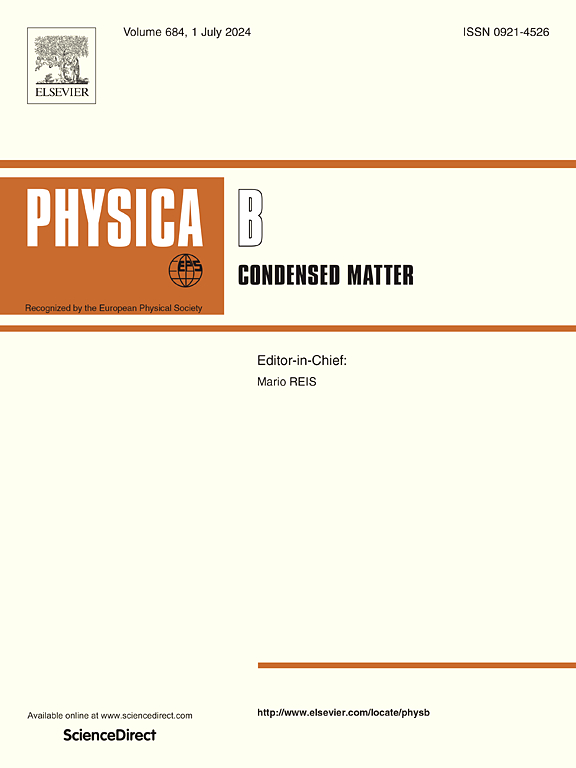Development and luminescent properties of Ce3+-doped KNaMg3Zn2-xSi12O30 blue-emitting phosphor via solid-state reaction method for white light-emitting diodes (WLEDs)
IF 2.8
3区 物理与天体物理
Q2 PHYSICS, CONDENSED MATTER
引用次数: 0
Abstract
A novel series of Ce3+-doped KNaMg3Zn2-xSi12O30 blue-emitting phosphors, with Ce3+ concentrations ranging from 1 to 11 mol%, was synthesized using the solid-state reaction method. Phase formation was confirmed by powder X-ray diffraction (XRD), and photoluminescence (PL) spectroscopy was employed to investigate the luminescent properties. Surface morphology was examined through scanning electron microscopy (SEM). The XRD patterns of the samples closely matched JCPDS card No. 48–0418, indicating successful phase formation. The optical characteristics of the synthesized phosphors were evaluated using emission and excitation spectra, along with decay curves. All the phosphors exhibited a strong blue emission at 441 nm, corresponding to the 5d-4f transition of Ce3+ ions. The PL emission spectra revealed an intense peak at 441 nm, resulting from electric dipole transitions upon excitation at 342 nm. The effect of Ce3+ concentration on photoluminescence intensity was also investigated, showing an increase in intensity with Ce3+ concentration up to 11 mol%, after which a decline was observed due to concentration quenching, attributed to dipole-dipole interactions. The optimized phosphor (11 mol% Ce3+), under 342 nm excitation, exhibited Commission Internationale de l'Éclairage (CIE) chromaticity coordinates, correlated color temperature (CCT), and color purity values of (0.1899, 0.1605) and 99.6 %, respectively. These results suggest that the Ce3+-doped KNaMg3Zn2-xSi12O30 phosphor is a promising candidate for blue phosphors in white light-emitting diode (WLED) applications.
白光二极管用Ce3+掺杂KNaMg3Zn2-xSi12O30蓝光荧光粉的固态反应制备及其发光性能
采用固相反应法制备了一系列Ce3+掺杂KNaMg3Zn2-xSi12O30蓝光荧光粉,Ce3+的浓度范围为1 ~ 11 mol%。通过粉末x射线衍射(XRD)证实了相的形成,并利用光致发光(PL)光谱研究了其发光性能。通过扫描电子显微镜(SEM)观察表面形貌。样品的XRD图谱与JCPDS卡号48-0418非常匹配,表明相形成成功。利用发射光谱和激发光谱以及衰减曲线对合成荧光粉的光学特性进行了评价。所有的荧光粉在441 nm处表现出强烈的蓝色发射,与Ce3+离子的5d-4f跃迁相对应。发光光谱显示在441 nm处有一个强烈的峰,这是由于在342 nm激发时的电偶极子跃迁造成的。Ce3+浓度对光致发光强度的影响也进行了研究,Ce3+浓度达到11 mol%时,光致发光强度增加,之后由于偶极-偶极相互作用引起的浓度猝灭,光致发光强度下降。优化后的荧光粉(11 mol% Ce3+)在342 nm激发下的色度坐标、相关色温(CCT)和色纯度分别为(0.1899,0.1605)和99.6%,符合国际CIE (Commission Internationale de l’Éclairage)标准。这些结果表明,Ce3+掺杂的KNaMg3Zn2-xSi12O30荧光粉是白光发光二极管(WLED)中蓝色荧光粉的理想候选材料。
本文章由计算机程序翻译,如有差异,请以英文原文为准。
求助全文
约1分钟内获得全文
求助全文
来源期刊

Physica B-condensed Matter
物理-物理:凝聚态物理
CiteScore
4.90
自引率
7.10%
发文量
703
审稿时长
44 days
期刊介绍:
Physica B: Condensed Matter comprises all condensed matter and material physics that involve theoretical, computational and experimental work.
Papers should contain further developments and a proper discussion on the physics of experimental or theoretical results in one of the following areas:
-Magnetism
-Materials physics
-Nanostructures and nanomaterials
-Optics and optical materials
-Quantum materials
-Semiconductors
-Strongly correlated systems
-Superconductivity
-Surfaces and interfaces
 求助内容:
求助内容: 应助结果提醒方式:
应助结果提醒方式:


